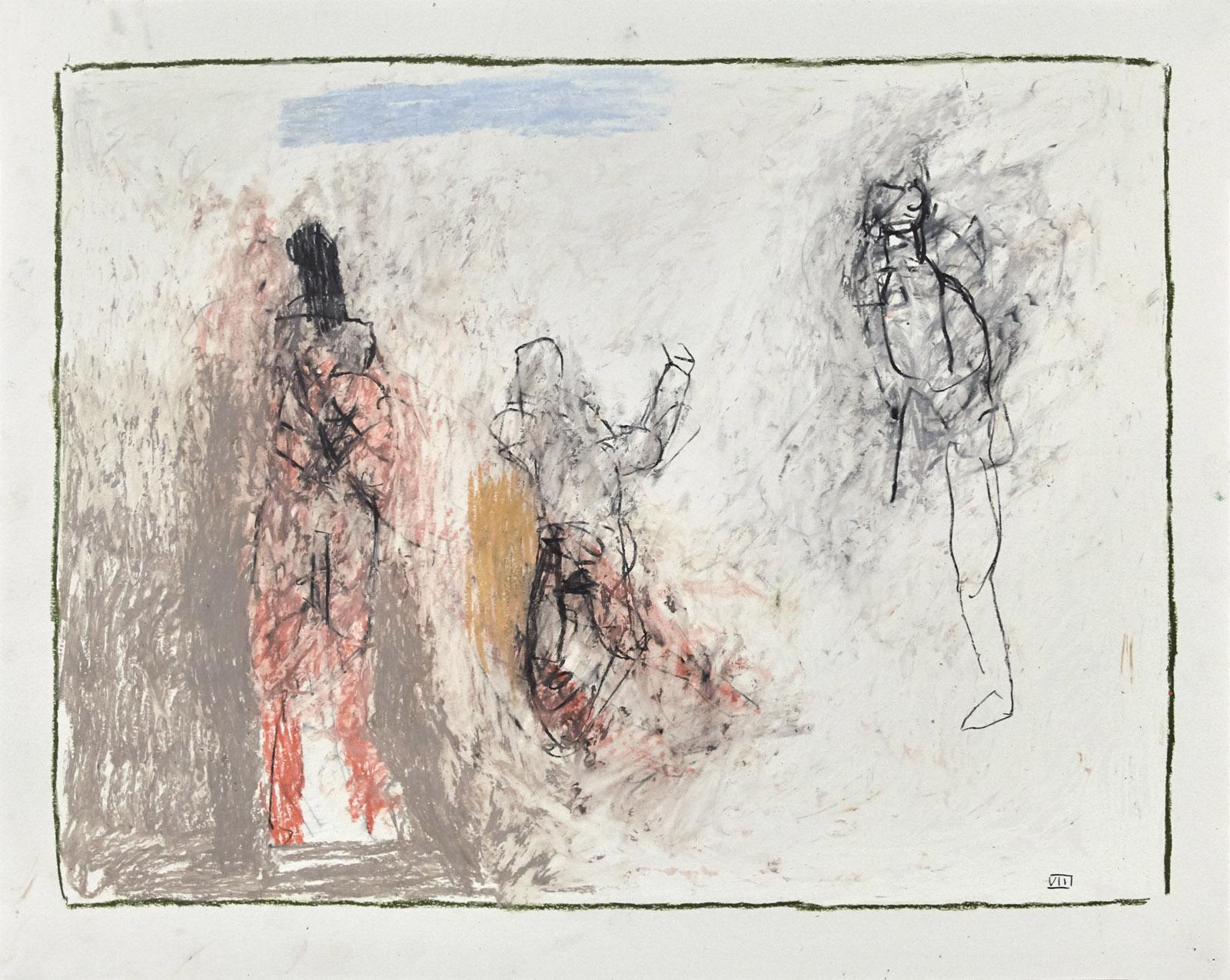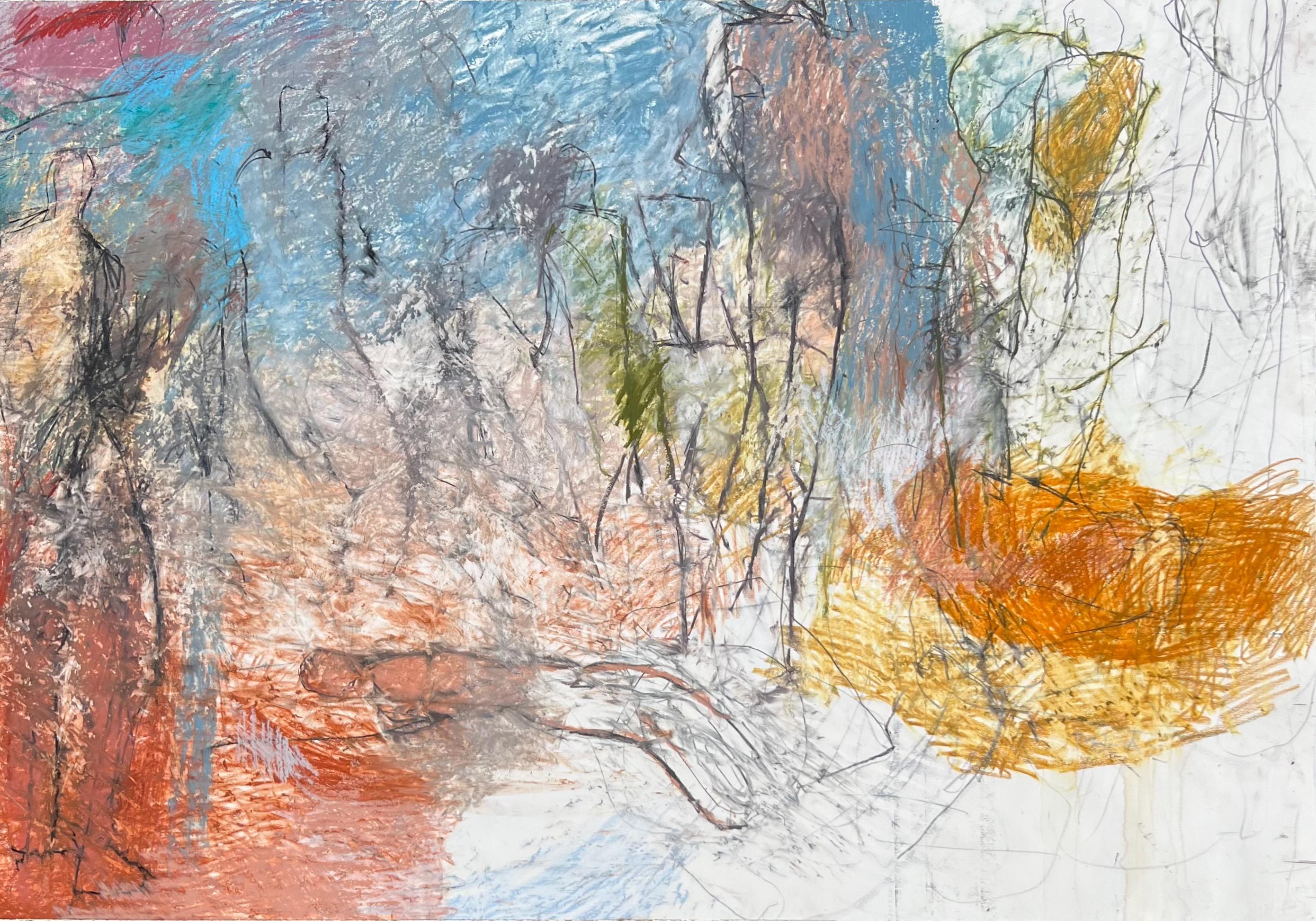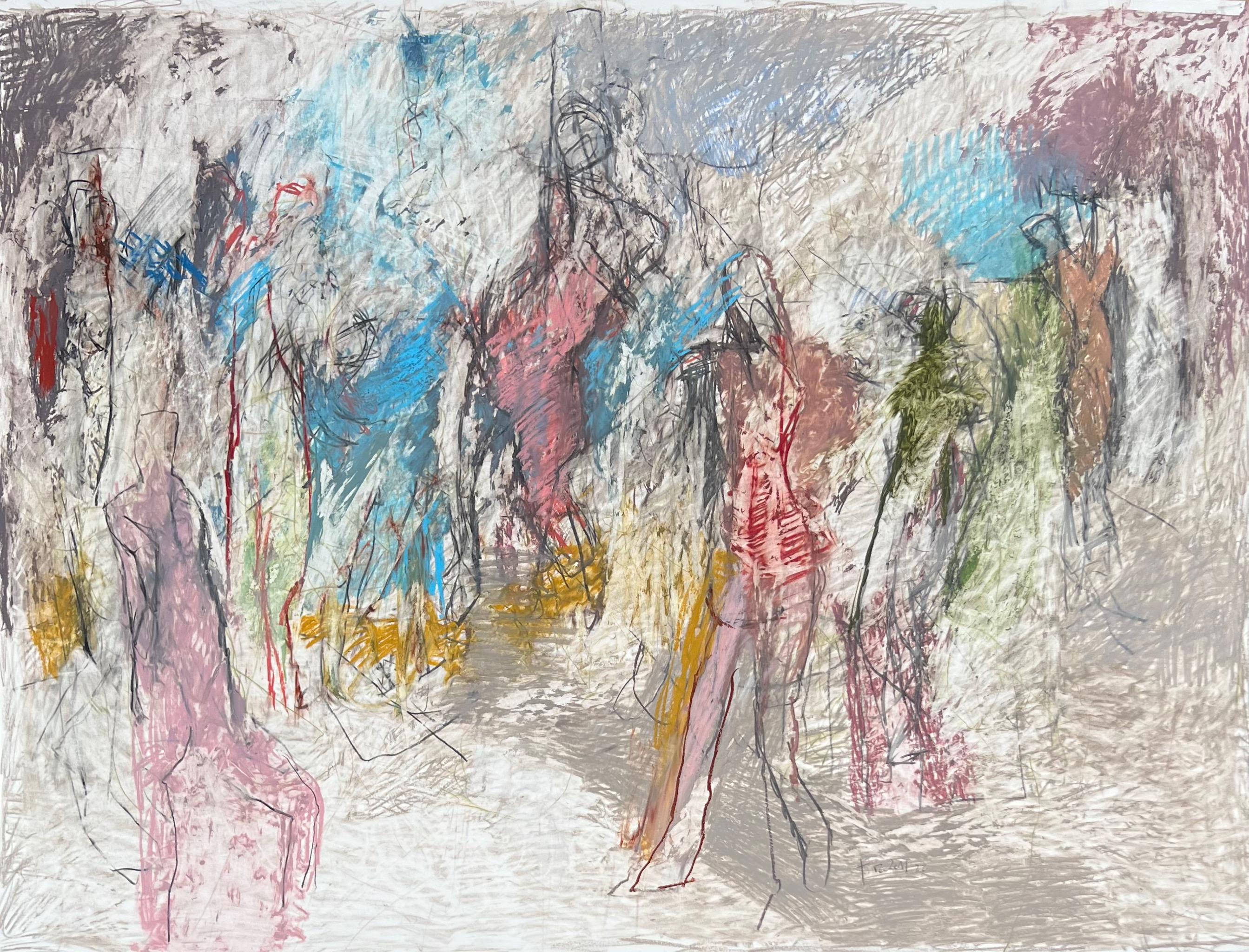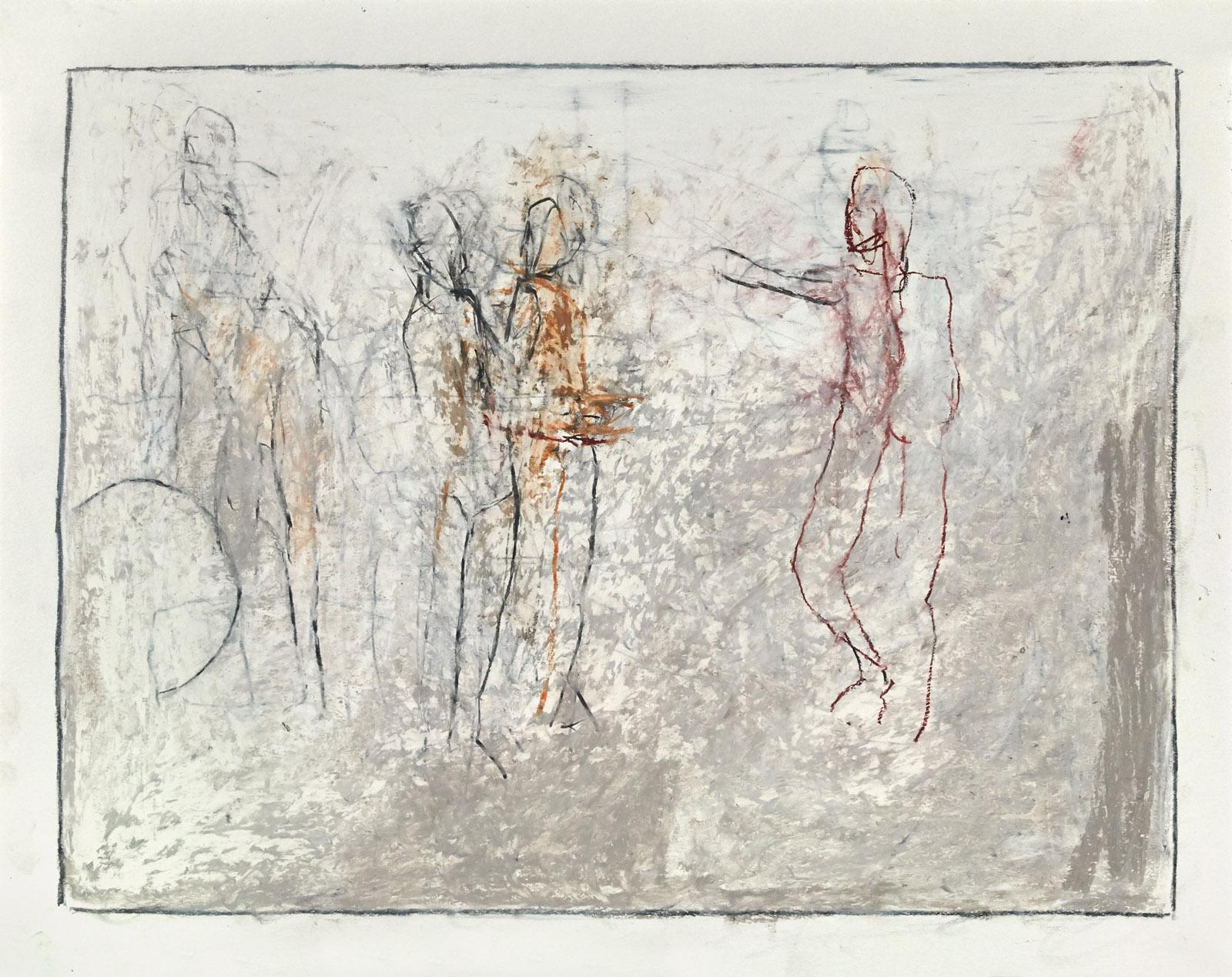Items Similar to Drawings from Mt Gretna, III
Want more images or videos?
Request additional images or videos from the seller
1 of 5
Thaddeus RadellDrawings from Mt Gretna, III2020
2020
About the Item
"My work principally consists of deeply abstracted figure compositions--intuitive constructions that begin with random marks establishing larger masses of torsos, heads, and limbs in an undefined setting. The emphasis is almost purely on intuition. The figures are born of their surrounding environment, emerging only partially and fugitively from the layers of pigment.
A narrative is evident but never overt. A crown, a shield, a boat, a wheel. Though the subject has recently coalesced around my reading of Dante and Shakespeare, the settings remain extremely vague- a beach, an interior, a woodland. The paintings are, in the end, meditations on the relationship between the protagonists in a wordless drama. In my paintings, I use a cold wax medium combined with dry pigments, oil paint, and embedded fragments of burlap. The surfaces eventually build up into a dense, rugged terrain."
--Thaddeus Radell
- Creator:Thaddeus Radell (1956, American)
- Creation Year:2020
- Dimensions:Height: 19 in (48.26 cm)Width: 25 in (63.5 cm)
- Medium:
- Movement & Style:
- Period:
- Condition:
- Gallery Location:Atlanta, GA
- Reference Number:
About the Seller
5.0
Gold Seller
These expertly vetted sellers are highly rated and consistently exceed customer expectations.
Established in 1983
1stDibs seller since 2022
17 sales on 1stDibs
Typical response time: <1 hour
- ShippingRetrieving quote...Ships From: Atlanta, GA
- Return PolicyA return for this item may be initiated within 7 days of delivery.
More From This SellerView All
- Prodigal Son (VIII)Located in Atlanta, GA"My work principally consists of deeply abstracted figure compositions--intuitive constructions that begin with random marks establishing larger masses of torsos, heads, and limbs in an undefined setting. The emphasis is almost purely on intuition. The figures are born of their surrounding environment, emerging only partially and fugitively from the layers of pigment. A narrative is evident but never overt. A crown, a shield, a boat, a wheel. Though the subject has recently coalesced around my reading of Dante and Shakespeare, the settings remain extremely vague- a beach, an interior, a woodland. The paintings are, in the end, meditations on the relationship between the protagonists in a wordless drama. In my paintings, I use a cold wax medium...Category
2010s Contemporary Figurative Drawings and Watercolors
MaterialsOil Crayon, Mixed Media, Handmade Paper, Graphite
- DreamLocated in Atlanta, GA"My work principally consists of deeply abstracted figure compositions--intuitive constructions that begin with random marks establishing larger masses of torsos, heads, and limbs in...Category
2010s Contemporary Figurative Drawings and Watercolors
MaterialsOil Crayon, Mixed Media, Handmade Paper, Graphite
- Drawings from Mt Gretna XXIXLocated in Atlanta, GA"My work principally consists of deeply abstracted figure compositions--intuitive constructions that begin with random marks establishing larger masses of torsos, heads, and limbs in...Category
2010s Contemporary Figurative Drawings and Watercolors
MaterialsOil Crayon, Mixed Media, Handmade Paper, Graphite
- At the ShoreLocated in Atlanta, GA"My work principally consists of deeply abstracted figure compositions--intuitive constructions that begin with random marks establishing larger masses of torsos, heads, and limbs in...Category
2010s Contemporary Figurative Drawings and Watercolors
MaterialsOil Crayon, Mixed Media, Handmade Paper, Graphite
- Four Figures and a ShieldLocated in Atlanta, GA"My work principally consists of deeply abstracted figure compositions--intuitive constructions that begin with random marks establishing larger masses of torsos, heads, and limbs in...Category
2010s Contemporary Figurative Drawings and Watercolors
MaterialsOil Crayon, Mixed Media, Handmade Paper, Graphite
- A Seraph (no. 2)Located in Atlanta, GAFramed dimensions 18.5 x 17.5 inches One of two original drawings of seraphim created for the British firm of stained-glass designers Shrigley and Hunt. The drawings are by the cele...Category
1880s Victorian Figurative Drawings and Watercolors
MaterialsChalk, Watercolor
You May Also Like
- Der Fled Maus (Figurative Drawing of Costumed Man with Moon on Teal Paper)By Nicholas Kahn & Richard SelesnickLocated in Hudson, NYFigurative drawing of a costumed man with two moons on handmade teal colored paper "Der Fled Maus", made by Kahn & Selesnick in 2011 mixed media, graphite, and pastel handmade paper 17 x 17 inches in walnut vintage wood frame with 8ply mat 7.5 x 7.5 inches unframed This whimsical mixed media drawing on handmade teal colored paper was made by the creative duo Nicholas Kahn & Richard Selesnick as part of their series "Truppe Fledermaus", wherein the artists celebrate the carnivalesque with a cast of peculiar costumed characters. In this illustration, a cloaked figure stands in front of a door with the moon, in two different phases, appearng in the background. The artists' highly stylized approach adds an almost vintage touch. The drawing is complemented by a simple vintage walnut frame, and a sturdy wire across the back provides for easy hanging. About Truppe Fledermaus: Kahn & Selesnick’s latest project follows a fictitious cabaret troupe – Truppe Fledermaus (Bat Troupe) – who travel the countryside staging absurd and inscrutable performances in abandoned landscapes for an audience of no one. The playful but dire message presented by the troupe is of impending ecological disaster, caused by rising waters and a warming planet, the immediate consequences of which include the extinction of the Bat, a shamanistic figure representing both nature and humanity. In one sense, the entire cabaret troupe can be seen as a direct reflection of the artists themselves, both entities employing farce and black humor to engage utterly serious concerns. About Kahn & Selesnick: Nicholas Kahn and Richard Selesnick...Category
2010s Modern Figurative Drawings and Watercolors
MaterialsGraphite, Pastel, Handmade Paper, Mixed Media
- Japanese Art Ukiyo-e Figurative Painting, Tomimoto Toyohina, Edo periodLocated in Segovia, ESBijing-Ga series XXVII (Nº 27) Title: Tomomoto Toyohina Tomimoto Toyohina was a much sought-after geisha (entertainer) who performed narrative ballads accompanied by the shamisen. She was one of several non-prostitute beauties, including teahouse waitresses, whom Utamaro depicted repeatedly in the early to mid 1790s. She appears here with a brush in hand, dressed and combed with simple elegance. This composition is from a six-print series comprising half-length portraits of famous beauties (Famous beauties of Edo). Utamaro elevated Tomimoto Toyohina to the status of one of the three most renowned beauties of her age (together with Okita and Ohisa). She was from a prominent family of musicians that provided entertainment in the Yoshiwara. Toyohina’s appeal undoubtedly was as much due to her appearance as to her skills in singing, and Utamaro’s celebration of her would have further elevated the status of an already well-known lineage. This image is part of the bijin-ga series (“Pretty women”) drawn by Mario BGil, based in the Kitigawa Utamaro woodblock print...Category
2010s Edo Figurative Drawings and Watercolors
MaterialsCrayon, Paper, Oil Crayon, Graphite
- Japanese Art Ukiyo-e Figurative Painting, The courtese Hinakoto, Edo periodLocated in Segovia, ESBijin-ga series XXI (Nº 21) Title: The courtese Hinakoto of the Hyôgorô House of Edo The courtesan Hinakoto is depicted by smoking tobacco. She takes the pipe delicately in her left hand and, in her right hand, she seems to be holding a “uchiwa” (rigid hand fan) that comes out from the bottom of the drawing, decorated with written calligraphy. Some strands of hair that fall on her temple and her scant clothing show that the painter has surprised her in a relaxed moment in which she does not lose her elegance and slenderness. This image is part of the bijin-ga series (“Pretty women”) drawn by Mario BGil, based in the Kitigawa Utamaro woodblock print...Category
2010s Edo Figurative Drawings and Watercolors
MaterialsCrayon, Paper, Oil Crayon, Graphite
- Japanese Art Ikiyo-e Figurative Painting, Obvious Love Arawaruru Koi, Edo periodLocated in Segovia, ESBIJIN-GA SERIES XVIII (Nº 18) Title: Obvious Love (Arawaruru Koi) This image is part of the bijin-ga series (“Pretty women”) drawn by Mario BGil, based in the Kitigawa Utamaro woodblock print Obvious Love (Arawaruru Koi) (1793-94); 38,8 x 26,2 cm.. Art Institute Chicago, USA. A sensual woman seems to care little that her kimono is open, exposing a breast. Her hair is in disarray , the hairpin at the front about to fall and she holds one of the hairpins in her left hand. She appears to be looking down outside the frame of the picture, perhaps in mid-conversation. The term “arawaruru” refers to a love so wholehearted that it expresses itself in the lover´s face and mannerisms. In the 1780's and 90's the publisher Tsutaya Juzaburo and the designer Kitagawa Utamaro worked together on the production of many woodblock prints, most of them of the bijin-ga type. One of their most popular productions was a set of images that purported to depict psychological classifications of women - 'fickle', 'interesting', etc.. Perhaps in response to this success, they then came up with something similar - a set of prints...Category
2010s Edo Figurative Drawings and Watercolors
MaterialsPaper, Graphite, Crayon, Oil Crayon
- Japanese Art Ukiyo-e Figurative Painting, Bijin Ôkubi, Edo PeriodLocated in Segovia, ESBijin-ga series XXIX (Nº 29) Title: Bijin Ôkubi Upper torso portrait of a Japanese beauty, depicted with a graceful hand gesture and an ornate headdress. Her soft round features contrast with the colourful sharp angles of the collars of her kimono. Her elongated oval face, straight nose and red butterfly lips are typical of the prototype of a beautiful woman, Bijin-ga. Her upper torso and face occupying the central section of the picture show a composition type that became known in time as Large-head pictures, or Okubi-e; compositions with which Utamaro became a model for generations of woodblock artists. This image is part of the Bijin-ga series (“Pretty women”) drawn by Mario BGil, based in the Kitigawa Utamaro woodblock print...Category
2010s Edo Figurative Drawings and Watercolors
MaterialsCrayon, Paper, Oil Crayon, Graphite
- Japanese Art Ukiyo-e Figurative Painting, Hanamurasaki of the Tamaya, Edo periodLocated in Segovia, ESPortrait of the top-class courtesan Hanamurasaki elegantly combed, and dressed in a simple formal kimono and obi, adorned with symbols of her okiya. She is sitting on her knees in a graceful pose, stretching her arms forward and crossing her fingers with a delicate movement of the wrists. This image is part of the “bijin-ga series” (Pretty women) drawn by Mario BGil, based in the Kitigawa Utamaro woodblock print “Hanamurasaky of the Tamaya”, (from the series: “Array of supreme beauties of the Present Day”, 1794), 36,2 x 25 cm. Museum of Fine Arts. Boston, USA. The artist reproduces the seal of the censor (Kiwame) and from the original publisher ("Tsutaya", climbing leaf)), between the two, the signature of Mario BGil written in Japanese, with the date 14 (2014). The mesaurements of the drawing are 76 x 56 cm. (29,92 x 22,05 in.), with a painted surface of 67 x 49,5 cm. With his work on the "bijing-ga series", Mario BGil wanted to embellish, give brilliance and volume to the images presented by japanese artist Kitigawa Utamaro in those beautiful engravings, ennobled with the patina of time, which have served as inspiration. The result obtained is almost life-size portraits, endowed with strong chromaticism and valuable contrasts, all enhanced, in turn, with the volume provided by the weight and rigidity of the paper, and its thick texture (Fabriano Artistico “grana grosso”, 640g/m2; the thickness and hardness of the paper makes it necessary to transport it without rolling). In this way, Mario BGil pays tribute to his admired artist and offers us a new and enriched vision of this popular facet of oriental art from the 18th and 19th centuries. ABOUT THE ARTIST Mario BGil is a self-taught artist who for years has combined his creative activity with his work in the business world, away from commercial art galleries. Man of very diverse interests and great artistic sensitivity, studied Art History and in 2012, a deep interest in oriental art was awakened in him so that he began to study the great masters of Japanese Ukiyo-e prints, who had such an influence on the European avant-garde of the late 19th century. The discovery of Kitagawa Utamaro (1753-1806), a key figure in the metropolitan culture of Edo (now Tokyo), and a point of reference in the history of Japanese engraving...Category
2010s Edo Figurative Drawings and Watercolors
MaterialsCrayon, Paper, Oil Crayon, Graphite
Recently Viewed
View AllMore Ways To Browse
Large Figurative Drawing
Beach Drawing
Large Figure Drawings
Fragment Head
Wax Figures
Cold Wax Medium
Drawing Torso
Meditation Figure
Contemporary Shakespeare
Oil On Burlap
Oil On Burlap Painting
Boat Wheel
Torso Fragment
Vintage Dress Drawing
Francis Bacon Painting
Vintage Dress Drawings
Vintage Dresses Drawing
Charcoal Drawing Paris





